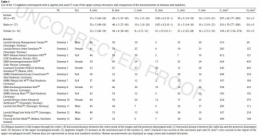Simulateurs d'airway: Fiables ?
21/05/2015
A radiographic comparison of human airway anatomy and airway manikins – Implications for manikin-based testing of artificial airways
Schalk R et Al. Resuscitation. 2015 May 11. pii: S0300-9572(15)00199-9
----------------------------------------------------------
La maîtrise des techniques de contrôle des voies aériennes est un des enjeux de la médecine préhospitalière militaire. Le recours à la simulation est devenu très fréquent. Pour autant ce travail montre que cette méthode d'apprentissage a ses limites. L'une d'entre elle est le fait que les simulateurs de tache ne reproduisent pas correctement l'anatomie des voies aériennes.
----------------------------------------------------------
Objective
The aim of this prospective, single-center, observational study was to investigate the accuracy of modeling and reproduction of human anatomical dimensions in manikins by comparing radiographic upper airway measurements of 13 different models with humans.
Methods
13 commonly used airway manikins (male or female anatomy based) and 47 controls (adult humans, 37 male, 10 female) were investigated using a mediosagittal and axial cervical spine CT scan. For anatomical comparison six human upper airway target structures, the following were measured: Oblique diameter of the tongue through the center, horizontal distance between the center point of the tongue and the posterior pharyngeal wall, horizontal distance between the vallecula and the posterior pharyngeal wall, distance of the upper oesophageal orifice length of epiglottis distance at the narrowest part of the trachea. Furthermore, the cross-section of the trachea in axial view and the cross-section of the upper oesophageal orifice in the same section was calculated. All measurements were compared gender specific, if the gender was non-specified with the whole sample.
Results
None of the included 13 different airway manikins matched anatomy in human controls ( n = 47) in all of the six measurements. The Laerdal Airway Management Trainer, however, replicated human airway anatomy at least satisfactorily.
Conclusion
This investigation showed that all of the examined manikins did not replicate human anatomy. Manikins should therefore be selected cautiously, depending on the type of airway securing procedure. Their widespread use as a replacement for in vivo trials in the field of airway management needs to be reconsidered.



Les commentaires sont fermés.